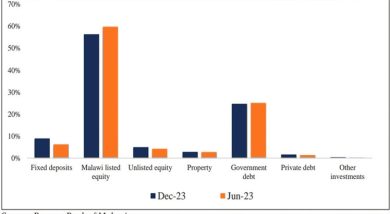Liquidity seems out of control
 The burgeoned liquidity over the past few weeks is an indication that monetary authorities appear helpless to control its upward spiral, money market analysts have said.
The burgeoned liquidity over the past few weeks is an indication that monetary authorities appear helpless to control its upward spiral, money market analysts have said.
As of last week, according to a report from investment and portfolio managers, Blantyre-based Alliance Capital Limited, liquidity shot up to K10 billion (about $60m), a 25 percent rise from K8.9 billion (about $54m) the previous week.
Analysts have long argued that liquidity, in other words, money in circulation, has been rising largely due to a shortage of foreign currency in Malawi for the past two years or so.
“Clearly, liquidity management remains a major challenge in the face of increasing kwacha balances due to unavailability of foreign exchange.
“Meaningful reduction in excess reserves is, perhaps, only achievable upon achieving reasonable inflows of foreign exchange reserves to settle the huge backlog of foreign bills,” said the report.
Malawi has been struggling to raise foreign currency largely because of lower export revenues from tobacco, the country’s main forex earner, and the lack of budgetary support from donors under the Common Approach to Budget Support (Cabs).
There is a $121 million (K20 billion) budget shortfall in the current financial year, according to the 2011/12 Mid-Year Budget Review.
The continued flooding of the money market with liquidity will likely be another factor that could be pushing inflation further up.
Malawi’s year-on-year inflation for March shot up to 11.4 from 10.9 percent in February and the rate has been on the rise for the past eight months since July 2011.
An analyst said the inability of the commercial banks to provide importers with requisite foreign exchange is another factor fuelling liquidity.
“Companies are unable to access foreign exchange; hence, keeping their money in the commercial banks which is being loaned to the public. The forex shortage appears to make it difficult for the monetary authorities to effect tight fiscal policies,” said the analyst.
The liquidity increase means there is more money in the system chasing few goods, which could trigger the rise in commodities price.
But the analyst said the issuing of a K30 billion (about $179m) bond in December 2011, two bonds of K10 billion each, and two bonds of K5 billion ($30m) each, is step by the monetary authorities to rein on the rising liquidity levels.
The two and three-year notes offer coupons (returns) of eight percent and 8.5 percent respectively, while coupon rates on four and five-year notes are 9.5 percent and 10 percent, respectively.
But since it opened, investors have shown they are unwilling to put their money in the longest ever bond in Malawi’s history.
At the last auction in March, only a two-year treasury note was subscribed raising K620 million (about $3.7m) at an average yields of 14.13 percent, way above the current inflation rate.





